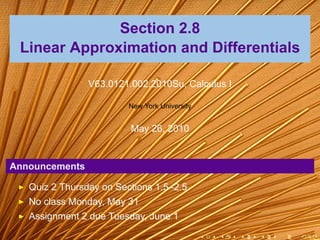This document summarizes a calculus lecture on linear approximations. It provides examples of using the tangent line to approximate the sine function at different points. Specifically, it estimates sin(61°) by taking linear approximations about 0 and about 60°. The linear approximation about 0 is x, giving a value of 1.06465. The linear approximation about 60° uses the fact that the sine is √3/2 and the derivative is √3/2 at π/3, giving a better approximation than using 0.




































































